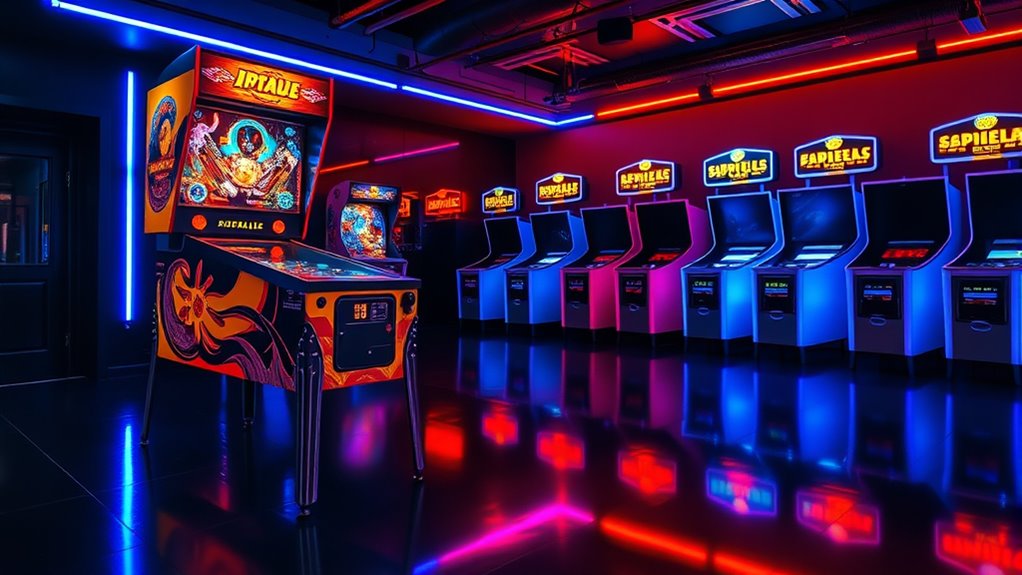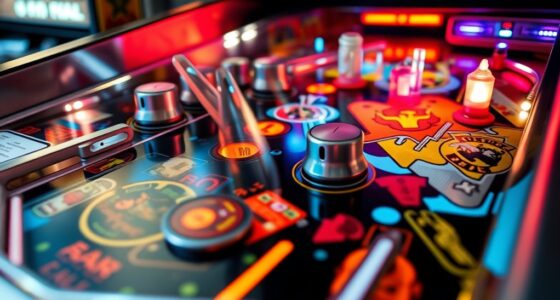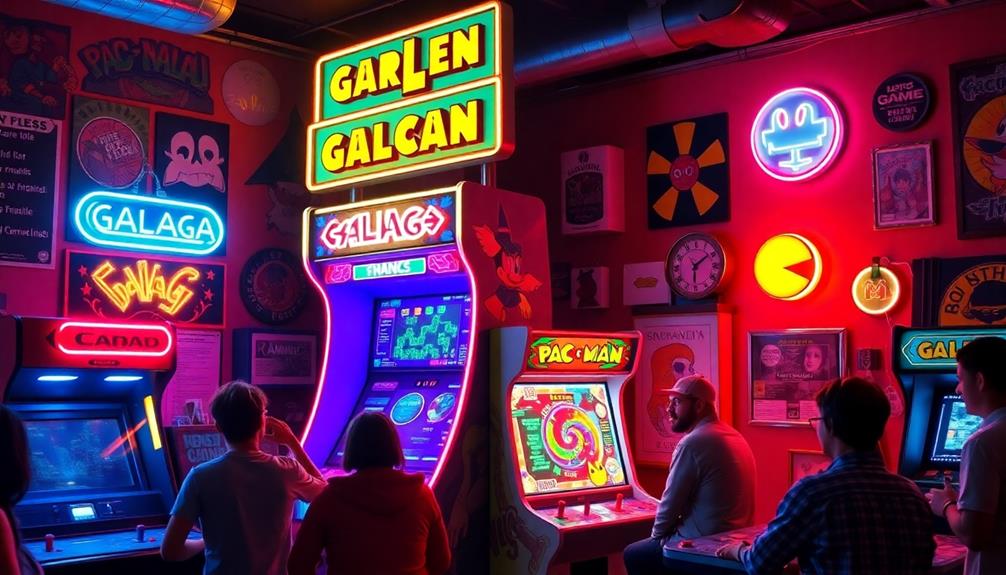The shift from solid-state hardware to Pinball 2000 marks a key moment in gaming innovation. Solid-state technology brought digital displays and more complex gameplay, revolutionizing entertainment. Pinball 2000 then blended physical pinball machines with digital screens, creating immersive hybrid experiences. This evolution shows how technology continuously enhances gameplay depth and interaction. If you follow the journey further, you’ll discover how these innovations laid the groundwork for today’s advanced gaming experiences.
Key Takeaways
- Solid-state hardware revolutionized pinball with digital displays and electronic controls, improving reliability and gameplay complexity.
- Pinball 2000 integrated digital screens with traditional mechanical playfields, creating hybrid gameplay experiences.
- The shift from purely mechanical to digital pinball systems marked a major technological milestone.
- Digital advancements enhanced graphics, sound, and interactivity, bridging classic pinball with modern technology.
- These innovations laid the groundwork for future digital and immersive gaming experiences in the entertainment industry.

Have you ever wondered how digital technology has transformed the way we live and work? It’s a fascinating journey that’s reshaped every aspect of daily life, especially in entertainment and gaming. As you explore this evolution, you’ll notice how the shift from simple, pixelated screens to immersive digital worlds has sparked a sense of virtual nostalgia. That longing for the classic arcade days or early console games isn’t just about reminiscing; it’s about recognizing how these experiences laid the groundwork for today’s gameplay evolution. The progression from solid-state hardware to complex digital systems has allowed developers to create richer, more engaging experiences, making gaming more accessible and immersive than ever before.
The early days of gaming were marked by straightforward, hardware-based interactions, but as digital technology advanced, so did the complexity and depth of gameplay. You’ve seen how the introduction of digital graphics and sound transformed the gaming landscape, giving rise to more intricate storytelling and gameplay mechanics. These changes fueled a new wave of innovation, blending nostalgia with modern technology. Virtual nostalgia, for many players, isn’t just about reliving old favorites; it’s about experiencing those classics through modern interfaces, often enhanced by digital remasters or emulators. This creates a bridge between generations of gamers, allowing you to appreciate the roots of gaming while enjoying cutting-edge features.
The gameplay evolution has gone hand-in-hand with technological leaps, especially when it comes to hardware like pinball machines, arcade cabinets, and home consoles. From the earliest solid-state devices to the advent of digital displays, each step has expanded what’s possible in gaming. The advent of Pinball 2000, for example, marked a significant milestone by combining digital displays with traditional pinball mechanics, creating a hybrid experience that captivated players. This innovation exemplifies how digital technology doesn’t replace physical gameplay but elevates it, making it more interactive and visually appealing. You can see this progression in how modern games incorporate augmented reality, virtual reality, and online multiplayer features, all building on the foundation laid by those early solid-state machines.
Frequently Asked Questions
How Did Digital Technology Impact Pinball Machine Design?
Digital technology transformed pinball machine design by enabling you to enjoy advanced features like virtual ball physics and LED lighting effects. These innovations make gameplay more realistic and visually stunning, drawing you into immersive experiences. You benefit from smoother ball movements and dynamic lighting that adapt to your actions, creating a modern, engaging game environment. Digital enhancements elevate traditional pinball, making it more exciting and visually appealing for players like you.
What Were the Major Challenges Transitioning From Analog to Digital Pinball?
Imagine steering a tightrope stretched between innovation and tradition. Moving from analog to digital pinball, you face hardware limitations that challenge performance and reliability. Upgrading user interfaces demands balancing complexity with user-friendliness, ensuring players aren’t overwhelmed. You must innovate within these constraints, blending familiar gameplay with new digital features, all while maintaining the excitement and tactile feel that define pinball. It’s a delicate dance between technological progress and preserving core appeal.
How Did Consumer Preferences Evolve During the Digital Era?
During the digital era, you notice consumer preferences shift toward nostalgic appeal and customization options. You’re drawn to machines that blend classic charm with modern features, allowing you to personalize your gameplay experience. As technology advances, players seek a mix of familiarity and innovation, prompting manufacturers to incorporate retro elements while offering extensive customization. This evolution keeps pinball engaging and relevant, satisfying both nostalgia and the desire for unique, tailored entertainment.
What Role Did Software Development Play in Pinball Innovation?
Software development played a vital role in pinball innovation by enabling better software integration and enhancing the user interface. You see, developers improved game logic, added dynamic features, and created more engaging experiences. They also designed intuitive interfaces, making gameplay smoother and more accessible. This technological progress allowed pinball machines to evolve beyond mechanical origins, offering players richer, more interactive entertainment options that kept pace with digital-era expectations.
How Does Pinball 2000 Compare to Earlier Digital Pinball Machines?
Imagine stepping into a scene from “Minority Report”: Pinball 2000 surpasses earlier digital pinball machines by blending virtual overlays with holographic displays, creating an immersive experience. Unlike its predecessors, it integrates real-time graphics with physical playfields, making the game feel alive and futuristic. You’ll find it more interactive, mesmerizing, and visually stunning, as the holographic elements seem to float above the real table, transforming pinball from simple mechanics into a dynamic digital spectacle.
Conclusion
As you reflect on this journey from solid-state technology to Pinball 2000, it’s clear that innovation isn’t just about machines—it’s about pushing boundaries and inspiring passion. Some believe this evolution was just a technical upgrade, but it’s more than that. It’s a demonstration to human creativity and our relentless pursuit of entertainment. Embrace the idea that every breakthrough sparks a new wave of excitement, proving the digital era’s true magic is in its endless possibility.








